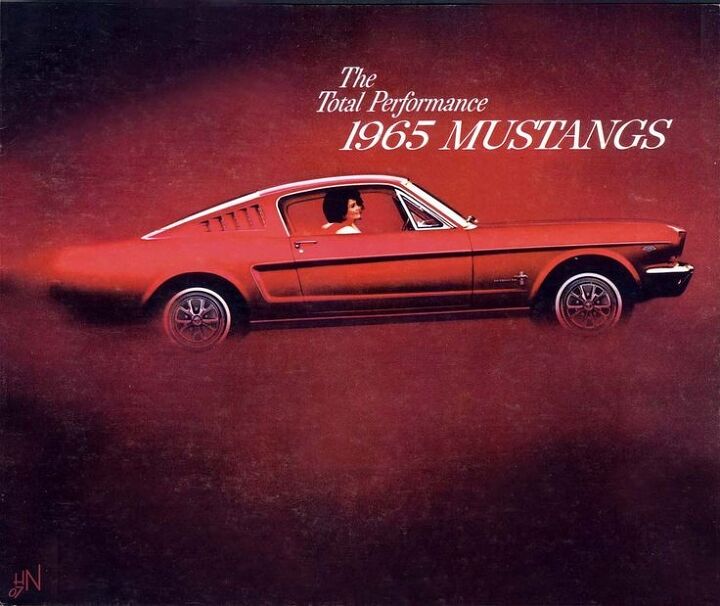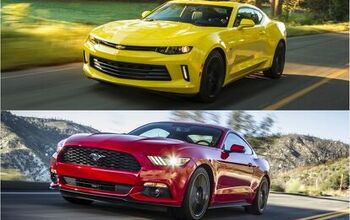QOTD: How Do You Rank the Six Generations of Mustang?

Yesterday, the B&B collectively lit up the Buy/Drive/Burn article regarding $45,000 coupes in praise of the V8-powered 2018 Mustang GT. While munching on all the delicious clicks, I thought about the QOTD published back in December 2017. In that post, I asked you, our dear readers, to rank all seven generations of the Chevrolet Corvette. See where this is going?
Today we want to know where you rank all six generations of the Ford Mustang. Line up your ponies!
Rule: Your ranking must include the entire generation as a whole, without distinction of design refreshes as separate items.
I. 1965-1973
First shown to the public at the New York World’s Fair in 1964, the Mustang project was the result of just 18 months of work at Ford. Donald Frey engineered the new Mustang after it was conceived by a Ford brand manager, one Lee Iacocca. Inline-six and V8 engines were available from the get-go, and the model started at under $2,500.
II. 1974-1978
The first generation suffered some serious size and brougham bloat over its tenure, growing from 181.6″ to 189.5″ in length, and increasing in width from 68.2″ to a chubby 74.1″. Ford sought to fix this with the Mustang II. Running on a shorter wheelbase and with a body shorter than the original model by six inches, the second Mustang shared a platform with the subcompact Pinto. Four cylinder engines were introduced in this generation, along with the Cologne 2.8-liter V6 and a Windsor V8.
III. 1979-1993
After the Mustang II, consumers were ready for some serious change. So Ford blessed them with the long-lived Fox body. Larger than the Mustang II, the third generation returned to very similar dimensions as the original. Success returned to Mustang in this generation, and a variety of engines fit under the hood — including, of course, the 5.0.
IV. 1994-2004
By the time the early ’90s rolled around, the square styling of the Fox body was looking a bit tired. Not wanting to jump ship entirely, the new Mustang for 1994 was based on a revised Fox platform called SN-95. “Aero is in!” said the new, rounded shape of the Mustang. Eight different engines were available in V6 or V8 guise. The SN-95 was the only model since the first generation to receive considerable styling changes during the run. A major refresh in 1999 turned on the New Edge charm, or what I’d call “Taco Bell parking lot styling.”
V. 2005-2014
The return to retro. Ford had been developing the fifth-generation Mustang since the New Edge version hit the scene in 1999, and finalized its design in 2002. Sweeping edges were replaced by blocky styling harking back to the ’60s. The size, however, was closer to a late first-gen Mustang. Very popular and refreshed for the 2010 model year, later S-197s have no trouble looking modern today.
VI. 2015-Present
In a travesty to some, the inline-four engine returned in 2015. Sticking with the retro theme established in 2005, the 2015 Mustang brought with it the fastback profile lost at the end of the Fox body in 1993. The V6 option went away after the 2017 model year; now it’s four or eight cylinders, and nothing between.
Where do you rank these six raging ponies?
[Images: Ford, Wikipedia, Carsindepth]

Interested in lots of cars and their various historical contexts. Started writing articles for TTAC in late 2016, when my first posts were QOTDs. From there I started a few new series like Rare Rides, Buy/Drive/Burn, Abandoned History, and most recently Rare Rides Icons. Operating from a home base in Cincinnati, Ohio, a relative auto journalist dead zone. Many of my articles are prompted by something I'll see on social media that sparks my interest and causes me to research. Finding articles and information from the early days of the internet and beyond that covers the little details lost to time: trim packages, color and wheel choices, interior fabrics. Beyond those, I'm fascinated by automotive industry experiments, both failures and successes. Lately I've taken an interest in AI, and generating "what if" type images for car models long dead. Reincarnating a modern Toyota Paseo, Lincoln Mark IX, or Isuzu Trooper through a text prompt is fun. Fun to post them on Twitter too, and watch people overreact. To that end, the social media I use most is Twitter, @CoreyLewis86. I also contribute pieces for Forbes Wheels and Forbes Home.
More by Corey Lewis
Latest Car Reviews
Read moreLatest Product Reviews
Read moreRecent Comments
- 28-Cars-Later One of the biggest reasons not to purchase an EV that I hear is...that they just all around suck for almost every use case imaginable.
- Theflyersfan A cheaper EV is likely to have a smaller battery (think Mazda MX-30 and Mitsubishi iMEV), so that makes it less useful for some buyers. Personally, my charging can only take place at work or at a four-charger station at the end of my street in a public lot, so that's a crapshoot. If a cheaper EV was able to capture what it seems like a lot of buyers want - sub-40K, 300+ mile range, up to 80% charging in 20-30 minutes (tops) - then they can possibly be added to some lists. But then the issues of depreciation and resale value come into play if someone wants to keep the car for a while. But since this question is asking person by person, if I had room for a second car to be garaged (off of the street), I would consider an EV for a second car and keep my current one as a weekend toy. But I can't do a 50K+ EV as a primary car with my uncertain charging infrastructure by me, road trips, and as a second car, the higher insurance rates and county taxes. Not yet at least. A plug in hybrid however is perfect.
- 28-Cars-Later Neither, but Honda lost the plot a while back in my view so Rav it would be.
- Kwik_Shift_Pro4X Nope. Still not interested.
- 28-Cars-Later I know someone who would snap this up for the right money, but Ontario and likely the ask would prohibit it.








































Comments
Join the conversation
OK, the 65-73 might be considered the same generation. But Bunkie Knudsen looked at the Mustang and thought "Hey- that car would look great as a Torino! And with that, the '71-'73's became just that. Torinos... with less room and trunk space. I swear GM must've paid Ford to hire that guy away and get him the hell out of the GM Tech Center. Favorites? 1. 1st Gen, ending with the '70. 2. Current car. Runs faster, jumps higher, looks like a million bucks. Prettiest coupe you can buy for under six figures, IMO. 3. 4th Gen. Quick car, fun to drive, blown Cobras are still giving Corvette owners fits. (Disclaimer, I owned a '01) 4. 5th Gen, for no special reason other than liking the body style. 5. 3rd Gen. Fox body brought performance back to the fold. 6. 2nd Gen. In it's defense, the Mustang may not be here today if that car didn't arrive when it did, in the form that it did.
Hmmm... 1. Gen VI 2. Gen V 3. Gen III 4. Gen IV 5. Gen I 6. Gen II The Gen VI cars are as big an improvement over the Gen V cars as they were over the Gen IV and III cars and with the GT350 one of the best driver's cars Ford has ever produced. The only two things I can really complain about are the panel fitment issues (it seems like Ford took a step back in that regard) and the weight. Anybody remember when Pericak had to back track on the supposed weight reduction over the outgoing 05-14 cars. It's a shame he couldn't deliver for whatever reason. If the Mustang had come in at similar weight numbers to the current Camaro it would have been absolutely brillant with the Gen III Coyote introduced with the 2018 Mustang GT and easily an mid 11 second car - of course that begs the question - would Ford have pushed the 5.0 as far as they have if the Gen VI car hadn't been so portly? The Gen V cars were a helluva improvement over the previous Mustangs and probably make for some of the best modern project cars. Cheap to mod and maintain with the strut front end and live rear axle. Hell Watson Engineering has a program where you can drop an 05-14 car off and have it converted over into a spec race car for NASA IIRC.